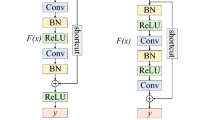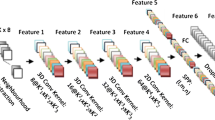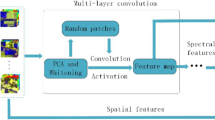Abstract
In hyperspectral image (HSI) classification, a big challenge is the limited sample size with a relatively high feature dimension. Therefore, effective feature extraction of data is essential, which is desired to remove the redundancy as well as improve the discrimination. A huge number of methods have been proposed for HSI feature extraction. In recent years, deep learning-based feature extraction algorithms have shown their superiorities in various classification problems. Within them, deep PCA (DPCA) is a simple but efficient algorithm, which runs fast due to the absence of back-propagation. However, DPCA fails to provide satisfactory classification accuracies on HSI datasets. In this paper, we try to combine DPCA with residual-based multi-scale feature extraction and propose a residual deep PCA (RDPCA) feature extraction algorithm for HSI classification. It is a hierarchical approach consisting of multiple layers. Within each layer, PCA is utilized for layer-wise feature extraction, and the reconstruction residual is fed into the next layer. When the feature is passed deeper into the RDPCA network, finer details are mined. The layer-wise features are concatenated to form the final output feature. Furthermore, to enhance the ability of nonlinear feature extraction, we add activation functions between adjacent layers. Experimental results on real-world HSI datasets have shown the superiority of the proposed RDPCA over DPCA and PCA.










Similar content being viewed by others
References
Tarabalka Y, Chanussot J, Benediktsson JA (2010) Segmentation and classification of hyperspectral images using watershed transformation. Pattern Recognit 43(7):2367–2379
Li W, Du Q, Zhang B (2015) Combined sparse and collaborative representation for hyperspectral target detection. Pattern Recognit 48(12):3904–3916
Li W, Du Q (2014) Gabor-filtering-based nearest regularized subspace for hyperspectral image classification. IEEE J Sel Top Appl Earth Obs Remote Sens 7(4):1012–1022
Akyürek HA, Koçer B (2019) Semi-supervised fuzzy neighborhood preserving analysis for feature extraction in hyperspectral remote sensing images. Neural Comput Appl 31(8):3385–3415
Deng Z, Sun H, Zhou S, Zhao J, Lei L, Zou H (2018) Multi-scale object detection in remote sensing imagery with convolutional neural networks. ISPRS J Photogramm Remote Sens 145:3–22
Bengio Y, Courville A, Vincent P (2013) Representation learning: a review and new perspectives. IEEE Trans Pattern Anal Mach Intell 35(8):1798–1828
Huang L, Chen C, Li W, Du Q (2016) Remote sensing image scene classification using multi-scale completed local binary patterns and fisher vectors. Remote Sens 8(6):483
Hinton G, Deng L, Yu D, Dahl GE, Ar Mohamed, Jaitly N, Senior A, Vanhoucke V, Nguyen P, Sainath TN et al (2012) Deep neural networks for acoustic modeling in speech recognition: the shared views of four research groups. IEEE Signal Process Mag 29(6):82–97
He K, Zhang X, Ren S, Sun J (2016) Deep residual learning for image recognition. In: Proceedings of the IEEE conference on computer vision and pattern recognition, pp 770–778
Ren S, He K, Girshick R, Sun J (2015) Faster R-CNN: towards real-time object detection with region proposal networks. In: Proceedings of advances in neural information processing systems, pp 91–99
Susskind J, Mnih V, Hinton G et al. (2011) On deep generative models with applications to recognition. In: Proceedings of IEEE conference on computer vision and pattern recognition, pp 2857–2864
Ma X, Geng J, Wang H (2015) Hyperspectral image classification via contextual deep learning. EURASIP J Image Video Process 1(2015):1–12
Zhang L, Zhang L, Du B (2016) Deep learning for remote sensing data: a technical tutorial on the state of the art. IEEE Geosci Remote Sens Mag 4(2):22–40
Chen Y, Lin Z, Zhao X, Wang G, Gu Y (2014) Deep learning-based classification of hyperspectral data. IEEE J Sel Top Appl Earth Obs Remote Sens 7(6):2094–2107
Chen Y, Zhao X, Jia X (2015) Spectral–spatial classification of hyperspectral data based on deep belief network. IEEE J Sel Top Appl Earth Obs Remote Sens 8(6):2381–2392
Pan B, Shi Z, Xu X (2018) MugNet: deep learning for hyperspectral image classification using limited samples. ISPRS J Photogramm Remote Sens 145:108–119
Mallat SG (1989) A theory for multiresolution signal decomposition: the wavelet representation. IEEE Trans Pattern Anal Mach Intell 11(7):674–693
De Bonet JS, Viola PA (1998) A non-parametric multi-scale statistical model for natural images. In: Proceedings of advances in neural information processing systems, pp 773–779
Kim Y, Koh YJ, Lee C, Kim S, Kim C (2015) Dark image enhancement based on pairwise target contrast and multi-scale detail boosting. In: Proceedings of IEEE international conference on image processing, pp 1404–1408
Liu Z, Song X, Tang Z (2015) Fusing hierarchical multi-scale local binary patterns and virtual mirror samples to perform face recognition. Neural Comput Appl 26(8):2013–2026
Yuan C, Sun X, Lv R (2016) Fingerprint liveness detection based on multi-scale LPQ and PCA. China Commun 13(7):60–65
Liao S, Zhu X, Lei Z, Zhang L, Li SZ (2007) Learning multi-scale block local binary patterns for face recognition. In: Proceedings of international conference on biometrics, pp 828–837
Gong Y, Wang L, Guo R, Lazebnik S (2014) Multi-scale orderless pooling of deep convolutional activation features. In: Proceedings of European conference on computer vision, pp 392–407
Gu H, Han Y, Yang Y, Li H, Liu Z, Soergel U, Blaschke T, Cui S (2018) An efficient parallel multi-scale segmentation method for remote sensing imagery. Remote Sens 10(4):1–18
Lin Y, Zhang B, Xu J, Li J, Zhao C, Yu D (2018) Hierarchical building extraction from high-resolution remote sensing imagery based on multi-feature and multi-scale method. In: Proceedings of international conference on multimedia and image processing, pp 17–23
Alam FI, Zhou J, Liew AWC, Jia X, Chanussot J, Gao Y (2019) Conditional random field and deep feature learning for hyperspectral image classification. IEEE Trans Geosci Remote Sens 57(3):1612–1628
Liong VE, Lu J, Wang G (2013) Face recognition using Deep PCA. In: Proceedings of international conference on information, communications and signal processing, pp 1–5
Lin TY, Dollar P, Girshick R, He K, Hariharan B, Belongie S (2017) Feature pyramid networks for object detection. In: Proceedings of the IEEE conference on computer vision and pattern recognition
Abdi H, Williams LJ (2010) Principal component analysis. Wiley Interdiscip Rev Comput Stat 2(4):433–459
Gonzalez RC, Woods RE et al (2002) Digital image processing. Prentice Hall, Upper Saddle River
Cheriyadat A, Bruce LM (2003) Why principal component analysis is not an appropriate feature extraction method for hyperspectral data. In: Proceedings of IEEE international geoscience and remote sensing symposium, pp 3420–3422
Marr D, Hildreth E (1980) Theory of edge detection. Proc R Soc Lond B Biol Sci 207(1167):187–217
Witkin AP (1983) Scale-space filtering. In: Proceedings of international joint conference on artificial intelligence, pp 1019–1022
Koenderink JJ (1984) The structure of images. Biol Cybern 50(5):363–370
GIC (2014) Hyperspectral remote sensing scenes. http://www.ehu.eus/ccwintco/index.php/Hyperspectral_Remote_Sensing_Scenes. Accessed 17 Oct 2019
Ye M, Zheng W, Lu H, Zeng X, Qian Y (2017) Cross-scene hyperspectral image classification based on DWT and manifold-constrained subspace learning. Int J Wavelets Multiresolut Inf Process 15(06):1750062
Acknowledgements
This study was funded by the National Natural Science Foundation of China (Grant Nos. 61701468, 61171151, 1571393 and 61272315) and International Cooperation Project of Zhejiang Provincial Science and Technology Department (Grant No. 2017C34003).
Author information
Authors and Affiliations
Corresponding author
Additional information
Publisher's Note
Springer Nature remains neutral with regard to jurisdictional claims in published maps and institutional affiliations.
Rights and permissions
About this article
Cite this article
Ye, M., Ji, C., Chen, H. et al. Residual deep PCA-based feature extraction for hyperspectral image classification. Neural Comput & Applic 32, 14287–14300 (2020). https://doi.org/10.1007/s00521-019-04503-3
Received:
Accepted:
Published:
Issue Date:
DOI: https://doi.org/10.1007/s00521-019-04503-3




